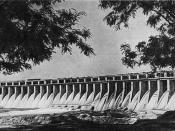Since the late 1920's Soviet economic planners almost obsessively concentrated on the development of heavy industry. They did this for the sake of developing more heavy industry--especially the expansion of steel production.
Under the First Five-Year Plan Soviet steel production (5.9 million tons) fell far short of the prescribed target of 10 million tons: but large-scale industrial production more than doubled, new blast furnaces were constructed and old ones modernized, and the foundations were laid for a Ural iron and steel center at Magnitogorsk and a western-Siberian one in the Kuznetsk basin (Kuzbas).
The Second Five-Year Plan brought a spectacular rise in steel production more than 17 million tons, placing the Soviet Union not far behind Germany as one of the major steel-producing countries of the world. As was the case with the other five-year plans, the second was not uniformly successful, failing to reach the recommended production levels in such crucial areas as coal, oil, and cement production.
The first two years of the Third Five-Year Plan proved to be even more of a disappointment in terms of proclaimed production goals. Even so, the value of these goals and of the coordination of an entire economy's development of central planning has been undeniable. For the 12% to 13% rate of annual industrial growth attained in the Soviet Union during the 1930's has few parallels in the economic history of other countries. What is more, this high rate of growth was resumed after World War II and continued into the early fifties, after which it has gradually declined.
The collectivisation of agriculture seems to have been a necessary prerequisite for the launching of the First Five-Year Plan. In 1928 80% of approximately 150 million Soviet citizens were engaged in agriculture. By the late twenties the peasant population, which was...


